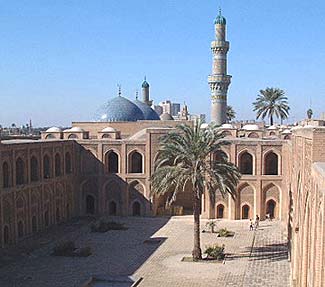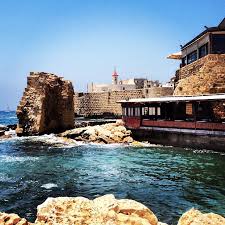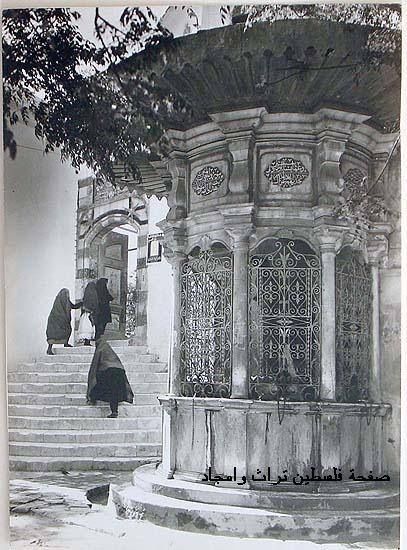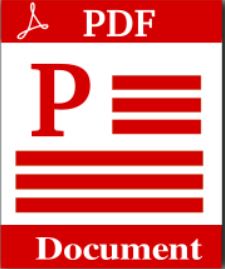


An Attempted Chronological Listing of Titled and other select Writings of Mirza Husayn `Ali Nuri, Baha'-Allah (d. 1892).
Stephen N. Lambden
In progress, April 27 2015 - under constant revision, correction and supplementation.
Introduction
This webpage will be devoted to an attempted chronological listing of major titled and select other mss. and printed writings of Baha'-Allah considered divine revelation by his followers, the Baha'is. The language(s) (Ar. Arabic/ Per. Persian) or languages in which they are written will be indicated as will, when known to the present writer on the basis of many previous researchers, the date and recepients of the text listed. Occasional brief notes will be added. In due course the opening lines and closing paragraphs or colophons will also be added. The order listing and implied datings of the scriptural Tablets below, are largely highly provisional and willin many cases, be frequently "corrected" or altered.
The dating of Bahā’-Allāh's Writings.
The precise dating of many, perhaps most of the alwah (scriptural Tablets) of Bahā’-Allāh, is not known with certainty. Precise datings are, however, occasionally given for writings dating to the last few decades of Bahā’-Allāh's lifetime; most notably when written as if by his amanuensis Mirza Aqa Jan, Khadim-Allāh (`The Servant of God'). At the present time, lack of precise dating even applies to such major works as the Kitab-i iqan (`The Book of Certitude', c.1861), Kitab-i aqdas (`Most Holy Book', c. 1873) and Kitab ahdi (`The Book of [the] My Covenant', c.1891). With the question of the dating of Baha'-Allah's writings one has to bear in mind the fact that a good many major texts (e.g. Rashh-i `ama'; Surat al-Haykal, etc) exist in more than one recension and in Persian and Arabic versions. Sometimes, furthermore, these multiple recensions of alwah are several years apart. Baha'-Allah also cited his own texts in recreated or re-revealed versions; for example, the Lawh-i Malika (Tablet to Queen Victoria) in the Lawh-i Ibn-i dhi`b, "Epistle to the Son of the Wolf").
Among the facors which future scholarship will need to take into account when attempting to date writings or revelations more precisely are :
- The evolving handwriting, language, style, content and claims of Bahā’-Allāh himself;
- The possible implications of any introduction, colophon or attached seals or signitures associated with a given Tablet;
- The handwriting and dating of the script of the amanuensis and/ or copyist.
- Factors within Babi-Baha'i and other historical sources contextualizing persons in receipt of alwah and/or events referred to in the Tablets;
- The lifespan, biogaphy, locations or travels of the recepient(s).
- Global mss. locations and related factors such as acquisition dates in libraries or such institutions, etc.
This study has hardly begun, except in the case of a limited number of largely major, titled alwah, or scriptutal Tablets.
As an indication of dating the following periods within which Baha'i sacred writings were most likely written will be indicated as follows :
The Persian Babi years (1844-1852). TB1. (1260->1269 = 1844->1852). Writings dating to the Persian years of the Bābī period (1844-1852) prior to Baha'-Allah's imprisonment in the notorious Siyāh Chāl ("Black Pit") dungeon in Tehran and the exile to Iraq. No reliable list of writings ascribed to Bahā'-Allāh during his earliest Bābī years is available. Various historical and scriptural sources do mention writings of these years though most do not seem to be extant.
The years in Iraq, Baghdad, Iraqi Kurdistan, etc (1853-1863). TB2 A-C covering three periods : TB2A - dating to the early few years in Iraq, Baghdad and elsewhere (1852-1854). TB2B- probably dating to the roughly two years of the period of the Iraq interregnum in Iraqi Kurdistan, Sulaymaniyya elsewhere (1854-1856). TB2C - dating to the post-Sulaymaniyya years in Iraq, mostly Baghdad (1856-May 1863). This period is followed by the time at Constaninople-Istanbul (1863), designated TB3 covering the year or so in Constantinople-Istanbul, 1863. At least five major alwah date from this period.
The years in Adrianople-Edirne (1863-August 1868). TB4. and divided into three : TB4A - dating to the first Adrianople-Edirne period before the break with Mirza Yahya Nuri (c.1831-1914) who came to oppose Baha'-Allah's theophanic claims; between mid. 1863 and March 1866.TB4B - dating to the second Adrianople-Edirne period of the emergent, independent Baha'i religion after the break with Mīrzā Yahyā Nuri in March 1866 until the move to the house of `Izzat Pāshā in August 1867 (around 1 year 6 months). TB4C - The third period. From the time of the move to the House of `Izzat Pasha (Aug. 1867) until the exile to Acre in Ottoman Palestine (Western Galilee, Aug. 1868). The years in Ottoman Palestine, Acre, Bahji, etc (1868-1892). TB5. This twenty-four year time period loosely divided up into five subdivisions : (TB5A - TB5E)

TB1 = The Persian Babi years, 1260->1269 = 1844->1852/3.
Alwah-i Badasht
- 1848 Lost ? The eighty-one alwah of the Badasht conference in Khurasan. Mentioned in Tarikh-i Zarandi (The Dawn-Breakers).

TB2 = The years in Iraq, Baghdad, Iraqi Kurdistan, etc (1852/3-1863).
- TB2 [XX] Tafsīr-i Hu [Huwa] (The Commentary on the "He is"). Ar. Seemingly in support of the leadership role of Mirza Yahya Nuri.
- TB2 [XX] Lawḥ-i kull al-ta`ām (The Tablet of All-Food). c. 1853-4. Ar. > Hajji Mirzā Kamāl al-Dīn Narāqī (d. c. 1298/1889), son of the renowned early Qajar scholar Mulla Aḥmad Narāqī (d. ). Probably written in 1270 AH/ late 1853 or early 1854 in reply to a question of the previously named Babi of Narāq about Qur'ān 3:87 on which Mirzā Yahyā had apparently composed an inadequate commentary.
- TB2 [XX] The Sūrat al-kifāya (The Surah of the Sufficiency), c. 1854. > A Babi figure named or entitled Jawad.
- TB2B [XX] Saqi az Ghayb-i Baqa ("The Cupbearer of the Invisible Eternity").
- TB2 [XX] Qaṣīda `izz varqā'iyya ("The Mighty Ode of the Dove"). c. 1272/1855.
- TB2B [XX] Az Bagh-i ilahi ("From the Divine Garden"). c. 1855-8.
- TB2B [XX] `Ishq az sidra-yi a`la amad ("Rapture came forth from the Most Transcendent Lote-Tree”). c. 1855-7.
- TB2 [XX] Tafsir ayat al-Nūr / Lawh-i aya-yi nur (The Commentary upon the Light Verse [of the Qur'an = Q. 24:35) or Tafsīr al-ḥurūfāt al-muqaṭṭa`ah (Commentary on the Isolated Letters"). c. 1857-8?. > Aqa-yi Rikab-Saz Shirazi
- TB2 [XX] Lawḥ-i kīmīya (I): An Alchemical Tablet to `Abbās, c.1856-60?.
- TB2 [XX] Lawḥ-i kīmīya (II) : An Alchemical Tablet expository of a Saying of Mary the Copt /Jewess. c.1856-60?.
- TB2 [XX] Lawh-i kīmīya (III) : An Alchemical Tablet about the Ḥajar ("Philosopher's Stone"). c. 1856-61?.
- TB2 [XX] Lawḥ-i madīnat al-tawḥīd (The Tablet of the City of the Divine Unity). c. 1857
- TB2 [XX] Lawḥ-i madīnat al-rida' (The Tablet of the City of the Radiant Acquiescence). c. 1857.
- TB2 [XX] The Hidden Book of Fatima or Kalimat-i Maknunah (The Hidden Words). c.1857-8.
- TB2 [XX] Sahifa-yi Shattiyya (The Scroll of the Torrent [Tigris]).
- TB2 [XX] The Haft vādī (The Seven Valleys). > Shaykh Muhyi al-Din of Khaniqin. c. 1857-8.
- TB2 [XX] The Chahar vādī (The Four Valleys) > Shaykh `Abd al-Rahman Khalis (d.1275/ 1858-9), a Talabani Shaykh, grandson of Mulla Mahmud Zangana (d. 1215/1800-1) of Bujan, and Qadiri Sufi leader and poet of Karkuk considered the founder of the Khalisiyya branch of the Qadiri Sufi order. Written c. 1857-8.
- TB2 [XX] Lawḥ-i ḥaqq (The Tablet of the Ultimately Real). c. 1859-60?
- TB2 [XX] Lawh-i Fitna (The Tablet of the Test). > Shams-i Jahan (The Sun of the World), known as Fitna ("Test") a grand-daughter of Fath `Ali Shah Qajar (born in Damghan. 5th Sept. 1772-d. 23rd Oct. 1834). Possibly to be dated to TB3.
- TB2 [XX] Lawh-i Shikkar Shikan Shavand (""Warblers, mellifluous-toned [Sugar smashing...]"). This title is a citation from the first hemistitch of a line from a poem of Muhammad Hafiz of Shiraz (c. 1325–1390 CE). > Mirza Husayn Mutavali-yi Qummi and Mirza Sa'id Khan Ansari, Mu'taman al-Mulk, Mushir al-Dawla (b. 1816- 5th March, 1884), Minister of Foreign Affairs of Nasir al-Din Shah (d. 1313/1896).
- TB2 [XX] Lawh-i Subhana Rabbi al-A`la ("Glorified be my Lord, the Most Exalted") or Lawh-i Harf al-Baqa' (The Tablet of the Letter of Eternity).
- TB2 [XX] Lawh-i [Musibat-i] Hurufat-i `Aliyyin / 'Aliyyat (Tablet regarding the Calamities of the Elevated Letters). In eight Parts. Dedicated to Mirza Muhammad-i Vazir, a cousin of Baha'-Allah (d. Nur. ??) in consolation for the wife, Hava, and the sister Maryam of the Vazir (so RB1: 122).
- TB2 [XX] Lawh-i Hur-i `ujab (The Tablet of the Wondrous Maiden).
- TB2 [XX] Lawh-i Ghulam al-Khuld (The Tablet of the Eternal Youth).
- TB2 [XX] Tafsīr-i Hu [Huwa] (The Commentary on the "He is").
- TB2 [XX] The Jawāhir al-asrār (Gems of the Mysteries), c. 1860-1
- TB2 [XX] The Kitāb-i īqān (The Book of Certitude). > In reply to questions of Hajji Mirza Muhammad-Taqi Shirazi, Consular Agent for Russia (Vakil al-Dawla), the maternal uncle of the Bab (d. Acre 1911), hence an Afnan. Written c. 1861-2. Persian with numerous Arabic citations.
- TB2 [XX] The Tablets of the Hair. Datings uncertain.
- TB2 [XX] Commentary on Qur'ān 36:14a, "And We strenghtened [the two of] them with a third". Dating uncertain.
- TB2 [XX] Lawh-i Mallah al-Quds (The Tablet of the Holy Mariner). Ar. + Per. Just after Naw Ruz, March (20th?) 1863.
- TB2 [XX] Halih, halih, halih, yā bishārat (Hallelujah, Hallelujah, Hallelujah, O Glad-Tidings!)
- TB2 [XX] Surat al-Sabr (The Tablet of Patience) or Lawh-i `Ayyub (Tablet of Job). 1863. > Haji Mirza Muhammad-Taqi Nayrizi, whom Baha'-Allah had named `Ayyub (qur'anic Arabic for the biblical figure Job), since he was a survivor of the battle of Nayriz.
- TB2 [XX] Lawh-i Bulbul al-Firaq (The Tablet of the Nightingale of Separation).
- TB2 [XX] Surat al-Hijr (The Surah of the Departure).
- TB2 [XX] Surat al-Dhikr (The Surah of the Remembrance).
- TB2 [34] Surat-Allah (The Surah of the Godhead).
- Tablets Commemorative of the Riḍwān period (May 1863).

TB3 = The time in Constantinople-Istanbul.1863.
- TB3 [01] Lawḥ-i Hawdaj [Samsun] (The Tablet of the Howdah).
- TB3 [02] Lawḥ-i `Abd al-`Aziz va Vukala (The Tablet to `Abd al-`Aziz and his ministers).
- TB3 [03 Lawḥ-i Nāqūs (The Tablet of the Bell).
- TB3 [04] Lawḥ-i Shams-i jamāl-i ilāhī (The Tablet of the Sun of the Divine Beauty).
- TB3 [05] Miscellaneous other Writings of the Constantinople-Istanbul Period.

TB4 = The years in Adrianople-Edirne (1863-August 1868).
- TB [01] Sūrat al-Mursal (The Surah of the Sent Messengers). c. 1864.
- TB [02] Sūrat al-Ahsab (The Surah of the Companions). c. 1864.
- TB [03] Lawh-i Ahmad (The Arabic Tabler of Ahmad). c. 1282 / 1865. > Mīrzā Aḥmad Yazdī (b. Yazd c. 1220/1805 - d. Tehran [or Qazvīn?], c. 1320/1902).
- TB [04] Lawh-i Ahmad (The Persian Tabler of Ahmad). c.1865-6. > Ḥajjī Mīrzā Aḥmad-i Kāshānī (d. Baghdad c. 1866).
- TB5 [X] Lawh-i Asl-i Kullu al-Khayr (The Foundation(s) of all Good) c. 1860-70?
- TB [05] Sūrat al-Ma`ani (The Surah of the Sublimities). c. 1865.
- TB [06] Sūrat al-Qamits (The Surah of the Robe). c. 1865.
- TB [07] Sūrat al-Fath (The Surah of the Opening). c. 1865.
- TB [08] Sūrat al-Khiṭāb (`The Surah of the Oration'). c. 1865.
- TB [09] Surat al-Ism (The Surah of the Name). c. 1865-6.
- TB [10] Sūrat al-Fadl (The Surah of the Divine Bounty). c. 1865-6.
- TB [11] Surat al-Zuhur (The Surah of the Manifestation [Theophany]). c. 1865-6.
- TB [12] Surat al-Hifz (The Surah of the Preserver). c. 1865-6.
- TB [13] Surat al-Jawad (The Surah for Jawad). c. 1865-6
- TB [14] Sūrat al-Man` (The Surah of the Abstracted One). c. 1866-7.
- TB [15] Sūrat al-Damm (The Surah of Blood). c. 1865-6.
- TB [16] Lawh al-Nuqta (The Surah of the Point). c. 1865-6
- TB [17] Lawh-i Baha' (The Surah of Baha' [Splendour]). c. 1865-6
- TB [18} Lawḥ-i Tuqā (The Tablet of the Fear of God, c. 1867).
- TB [19] Lawh-i Laylat al-Quds (The Tablet of the Sacred Night). c. 1865-6
- TB [20] Surat al-Amr I (The Surah of the Command [I]). c. 1865-6
- TB [21] Sūrat al-qadīr (The Surah of the Omnipotent). c. 1865-6
- TB [22] Commentary on the basmala and Q. 68:1: "N" (Nūn). By the Pen!". c.1867?
- TB [23] The Tablet to `Alī Muhammad Sarrāj [Sirāj]. c. 1867.
- TB [ 24] Lawh-i Sayyah (The Tablet of the Traveler). c. 1867.
- TB [25] Tablet to Joseph Arthur Comte de Gobineau (b. near Paris, 1816-d. Turin, 1882), Diplomat, orientalist and writer.
- Lawh-i Napuliyun I (The First Tablet to Napolean III )`Emperor of the French [France]'; b. 1808- d. Chislehurst, UK, 9th Jan. 1873).
- TB [26] Lawh-i Nasir al-Din Shah, Qajar Shah (b. r. 1264/1848 - d. 1313/1896). c. 1867-8. Ar. + Per. Delivered Acre period by the young Bahā'i martyr Mirza Āqā Buzūrg-i Khurasānī (1852-1871) entitled ﺑﺪﻳﻊ Badi` (The Wondrous, Revolutionary) and grandson of the Baha'i martyr `Abd al-Majid Nishapuri.
- TB [X] Surat al-Ra'is (Per. Sura-yi-Ra'is), Tablet to the Leader 1869 = Akka, Lawh-i-Ra'is).


TB5 = The years in Ottoman Palestine, Acre, Bahji, etc (1868-1892).
- TB5 [00] c. 1868.
- TB5 [00] c. 1868.
- TB5[01] c. 1868-9.
- TB5 [02] c. 1868-9.
- TB5 [03] Tablets to `Ali Paşa [Pasha] Muhammad Amin (b. Istanbul, 1815 -d. Bebek,1871), Grand Vizir of Ottoman Empire. c. 1868. Also known as the Lawh-i Ra'is ("Tablet to the Leader"). In honour of Haji Muhammad Isma'il Kashani, Dhabih & Anis (The Companion). c. 1868-9.
- Surat al-Ra'is (Per. Suri-yi-Ra'is)
- TB5 [04] Lawh-i [Keçecizade Mehmed] Fu'ad Pasha (b. Istanbul, 1815-d. Nice, France, 12th Feb. 1869), Turkish Foreign Minister (1850s and 1860s) + Grand Vizier (1861-3+1863-6). Also known as the Lawh-i Kaf Za (K-Z = Kazim Samandar). c. 1869-70.
- TB5 [05] L-Pāp = Lawḥ-i. Pāp (Tablet to the Pope Pius IX) 1868-9. Addressed to Giovanni Maria Mastai-Ferretti, Pope Pius IX (born May 13, 1792, Senigallia, Papal States; reigned 16 June 1846 - d. Vatican City, Feb 7th, 1878). Beatified September 3, 2000.
- Lawh-i Napuliyun II (The Second Tablet to Napolean III `Emperor of the French [France]'; 1808- d. Chislehurst, UK, 9th Jan. 1873).
- TB5 [06] L-Malika /Vikturyia = The Tablet to Queen [Alexandrina] Victoria (24 May 1819 – 22 January 1901), British Queen from 1837 and later Empress of India. Communicated c. 1868-9
- TB5 [07] L-Malik Rus = The Tablet to the Czar of Russia, Nicolaevitch Alexander II (b. Moscow, 1818; r. 2nd March 1855 – d. 13th March 1881). c. 1868-9
- TB5 [08] c. 1868-9
- TB5 [09] Surat al-Haykal (The Surah of the Temple), A compilation by Baha'-Allah himself of several of his `Tablets to the Kings, Rulers and Religious Leaders'. c. 1870?
- TB5 [10] Lawḥ-i qinā' (The Tablet of the Veil). c. 1871-2. > Hajji Mirza Muhammad Karim Khan Kirmani (d.1871).
- TB5 [11] Lawh-i ṭibb (The Tablet of Medicine). c. 1872.
- TB5 [12] Lawḥ-i Qā'im (messianic Ariser) and Qayyūm (Deity Self-Subsistent). c. 1870-1.
- TB5 [13] Lawḥ-i Hartīk [Hirtīk] (The Tablet to Georg David Hardegg). Written for the Templar leader, 1872 CE.
- TB5 [14] Lawh-i -Pisar -`Amm (Tablet to the Cousin) c. 1872-3.
- TB5 [15] Lawh-i -Qad Ihtaraq al-mukhlisun ("The Fire Tablet") > Hajji Sayyid `Ali-Akbar Dahaji. c. 1872-3.
- TB5[16] c. 1872-3.
- TB5 [17] c. 1874-5.
- TB5 [18] c. 1874-5
- TB5 [19] Lawḥ-i amvāj (The Tablet of the Waves). c. 1872-3. Persian (+ Arabic) c. 1875-85? > `Āqā Siyyid Yaḥyā.
- TB5 [20] Tablet of Bahā’-Allāh to `Abd al-Razzāq al-Kashānī, the Lawḥ-i qabl az Ādam (Tablet regarding the Pre-Islamic Era) c.1874-5.
- TB5 [X] Lawh-i Ridwan -Ridwan Tablet of the Acre Period.
- TB5 [X] Lawḥ-i Basīṭ al-Haqīqa (The Tablet about Uncompounded Reality); on the implications of the phrase of Muhammad ibn Ibrahim ibn Yahya Qawami Shirazi (c. 1571–1636) or Mulla Sadra al-Din Shirazi : "The Basīṭ al-Haqīqa (Unicity [Simplicity] of Reality) is all things (kullu shay') but nothing in particular" (al-Asfar VI:111).
- TB5 [X] Lawḥ-i ru'yā (The Tablet of the Vision).
- TB5 [X] Lawḥ-i ẓuhūr [1] (The Tablet regarding the nature of the Divine theophany).
- TB5 [X] Lawḥ-i baqā' (The Tablet of Eternity).
- TB5 [X] Lawḥ-i mawlūd (The Tablet for the Birthday of the Bāb).
- TB5 [X] Lawḥ-i milād (1) (The Tablet for the Birthday of Bahā'-Allāh).
- TB5 [X] Lawḥ-i milād-i ism-i a`ẓam (1) (A Tablet for the Birthday of the Greatest Name).
- TB5 [X] Lawh-i -Hikmat (Tablet of Wisdom). > Aqa Muhammad Qa'ini (Naw-Firist, near Birjand, 29th March 1829-d. Bukhara, 6th July 1893), Nabil-i Akbar (The Greatest Nabil [=Muhammad]). One time pupil of the poet-philosopher Hajji Mirza Hadi Sabzavari and of the Majra al-Taqlid, Shaykh Murtada al-Ansari.
- TB5 [X] Lawh-i Ishraqat > 9th Dhu'l-Qada 1302/20th August, 1885
- TB5 [X] TB5 [X] Lawh-i Tajalliyat (Effulgences),
- TB5 [X] Lawh-i -Dunya (Tablet of the World) > Mirza Aqa-yi Afnan, Nur al-Din
- TB5 [X] Lawh-i Ard-i Ba' (Tablet of the Land of "B" =Beirut).
- TB5 [X] Lawh-i Tarazat (Ornaments). Dhu'l-Hija, 1305/August-Sept. 1888.
- TB5 [X] Lawh-i Burhan ("The Tablet of the Proof") > Shaykh Muhammad Baqir Isfahani (d. Najaf, 1883)
- TB5 [X] Kalimat-i Firdawsiyya (Words of Paradise)
- TB5 [X]
- TB5 [X] Lawh-i Ittihad
- TB5 [X] Lawh-i -Bisharat (Tablet of Glad- Tidings)
- TB5 [X]
- TB5D [X] A Tablet of Bahā'-Allāh commenting upon that verse of his al-Kitab al-aqdas about the question of an international auxilary language and script. (c.1890?).
- TB5D [X] Lawh-i -Karmil (Tablet of [Mount] Carmel), c. 1890-91.
- TB5D [X] Lawh-i Ibn-i Dhi`b (Epistle to the son of the Wolf") > Shaykh Muhammad Taqi, Aqa Najafi Isfahani (b. Isfahan, 18th April 1846-d.Isfahan, July 5th 1914).
- TB5D [X] Kitab -i Ahdi (The Book of My Covenant/ The Book of the Covenant), c. 1891 CE.
- TB5D [X]
- TB5D [X]
- TB5D [X]
- TB5D [X]
- TB5D [X]
Significant Acre Period Tablets to select Babi-Baha'i Individuals.
- TB [X] Tablets to Afnan or Members of the Family of the Bab.
- TB [X] Tablets to Hurufat al-Hayy (Letters of the Living).
- TB [X]
- TB [X] Mirza 'Alí Muhammad Varqa (d. 1896), the father of the child martyr Rúhu'lláh (The Spirit of God).
- TB [X] Mulla Sadiq-i Muqaddas Khurasani, entitled Ism-Allah al-Asdaq (The Name of God, the Most Holy).
- TB [X] Tablets to Nabīl-i Zarandī (1831-1892) entitled نبيل أعظم Nabil-i A`zam ("The Most Great Nabīl [=Muhammad]").
- TB [X] Tablets to Muhammad Kaẓim Qazvini (1844-1918) known as كاظم السمندر Kazim-i Samandar (`The Phoenix').
- TB [X] Tablets to Mirza Ḥusayn Isfahani (1826-1912) entitled مشكین قلم Mishkin Qalam (Musk-Scented Pen).
- TB [X] Tablets to Mirza `Ali-Muhammad (d.1928), known as Ibn-i Asdaq (The Son of the Most Holy).
- TB [X] Tablets to Aqa Muhammad-i Qa'ini (1829–1892), known as نبيل الأكبر Nabíl-i-Akbar (The Greatest Nabil [Muhammad]).
- Lawh-i Khalīl [Muballigh]-i Shirazi
- Lawh-i Mīrzā `Abbās Āstarābadī on the opening of the Shi`i Ramadan Dawn Prayer (Du`ā al-saḥar) attributed to Imam the 5th Imam Muhammad al-Bāqir (c. 57/676- d. c.126/743) and the word baha' as the al-ism al-a`zam (Mightiest Name [of God]) and person of Baha'-Allah.
- TB [X] Hajji Mulla `Alí-Akbar (1842–1910), known as Hajji Akhund (The Pilgrim Cleric).
- TB [X] Lawh-i Jamal-i Burujirdi (18XX-19XX), a leaned but arrogant Mujtahid, a Babi then Baha'i from the 1860s. He was eventulally regarded by `Abd al-Baha' as a covenant-breaker, but had received fifty or more Tablets from Baha'-Allah.
Significant Acre Period Tablets to select Ottoman statesman.
Mid-Late `Acre period for Jews
- TB [X] Lawḥ-i ba`ath-i mūsā (A Tablet to Khalīl about the Call of Moses).
- TB [X] The Ṣaḥīfat Allāh (The Scroll of God).
- TB [X]
Mid-Late `Acre period for Christians
- TB [X] The Lawh-i aqdas (Most Holy Tablet) for Fāris Effendi.
- TB [X] The letter of Fāris Effendi to Baha'-Allah.
- TB [X] Lawh-i Fāris Effendi (A Further Tablet to Fāris Effendi)
- TB [X] Another Tablet for Fāris Effendi.
- TB [X]
- TB [X]
- TB [X]
SCRIPTURAL TABLETS TO ZOROASTRIANS
Mid-Late `Acre period Writings for Zoroastrians
Alwah (Scriptural Tablets) of Baha'-Allah to Zoroastrians or to Zoroastrian Converts to the Baha'i Religion
- TB [X] Lawh-i Mānekjī > Mānekjī Līmjī Hūshang Hātaryā. Persian.
- TB [X] Lawh-i Haft Purshish (The Tablet of the Seven Questions)/ Lawh-i Shir-Mard.
- TB [X]
- TB [X]
The Lawh-i Hushang Mānekjī Limji (Add).
- Hātaryā- Mānekjī Līmjī Hūshang-Lawh-i Mānekjī -Some Introductory Notes.
- Hātaryā- Mānekjī Līmjī Hūshang-Lawh-i Mānekjī - Texts and mss.
 PDf. Mss. and printed editions of the original Persian text of the above named scriptural Tablet.
PDf. Mss. and printed editions of the original Persian text of the above named scriptural Tablet. - Hātaryā- Mānekjī Līmjī Hūshang-Lawh-i Mānekjī - Commentary
The Lawh-i haft Pursish or `Tablet of the Seven Questions'.
- The Lawh-i haft Pursish or `Tablet of the Seven Questions'. Introduction.
Significant Acre Period Tablets for Visitation (Ziyarat-Nama).
- Ziyārat-nama for Fatima Baraghani, Ṭāhirih, Qurrat al-`Ayn (d. 1852).
- Ziyārat-nāma of Ḥajjī Shaykh Muhammad `Alī (entitled) Nabīl ibn Nabīl (d. Istanbul 1307/1890)



